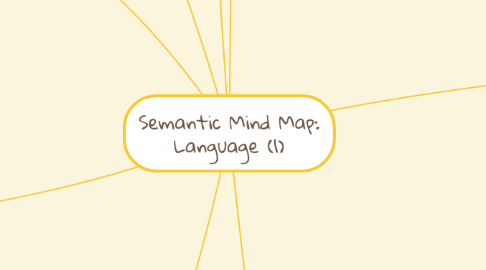
1. Human Language
1.1. Physiology
1.1.1. Larynx is lower
1.1.1.1. Physicality of jaw/tongue
1.2. Discreteness
1.2.1. Individual sounds
1.2.1.1. Form words
1.2.1.1.1. Form sentences
1.3. Grammar
1.3.1. System of rules
1.3.2. English language
1.3.2.1. Different meanings
1.3.2.1.1. Polysemous
1.4. Productivity
1.4.1. Creates infinite messages
1.4.1.1. Slang
1.5. Displacement
1.5.1. Fictional Events
1.5.2. Go forward
1.5.2.1. Future
1.5.3. Go backwards
1.5.3.1. Past
2. Pragmatics
2.1. Studies how we govern our choices of language
2.1.1. Social awareness
2.1.1.1. How to address different people
2.2. Pragmatics in written language
2.2.1. Figurative language
2.2.1.1. Metaphors
2.2.1.2. Similes
2.2.1.3. Irony
2.2.1.4. Euphemism
3. Semantics
3.1. Syntax
3.1.1. Arrangement of words
3.1.1.1. Create well-structure sentences
3.1.2. Compositional (phrasal) semantics
3.1.2.1. Words and syntax make sentences
3.1.2.1.1. Defining the meaning
3.1.3. Lexical semantics
3.1.3.1. Examine individual words and relationship
3.1.3.1.1. Synonyms
3.1.3.1.2. Antonyms
3.1.3.2. Lexical field
3.1.3.2.1. Hyponym
4. Vocabulary Development
4.1. Introducing new word
4.1.1. 4-step approach
4.1.1.1. Provide simple definition
4.1.1.2. Provide example (relate it to their life)
4.1.1.3. Encourage them to give example
4.1.1.4. Find more examples and repeat
4.2. Polysemy
4.3. Connotation/Denotation
4.3.1. Connotation
4.3.1.1. An idea
4.3.2. Denotation
4.3.2.1. Definition
4.4. Identifying word families
4.4.1. Builds phonemic awareness
4.4.1.1. Key to reading/literacy skills
4.5. Receptive/Productive word knowledge
4.5.1. Receptive (passive)
4.5.1.1. Recognize word and recall meaning
4.5.2. Productive (active)
4.5.2.1. Ability to speak or write needed vocabulary
4.6. High frequency word lists
4.6.1. General Word List
4.6.2. Dolch Word List
5. Orthography
5.1. Spelling system of language
5.1.1. Many letters have different sounds
5.1.2. English is a mixture of many languages
5.1.3. Many changes over time in the English language
5.2. 6 Syllable Spelling Patterns
5.2.1. Closed syllables
5.2.2. Open syllables
5.2.3. Silent E (vowel-consonant-e)
5.2.4. Vowel team
5.2.5. Vowel-R syllables
5.2.6. Consonant-le (C-le) syllables
6. Language Acquisition
6.1. Nativist
6.1.1. Biological
6.1.1.1. No formal instruction
6.1.2. Chomsky
6.1.2.1. Universal grammar
6.2. Hear string of sounds
6.2.1. Parsing
6.3. Functionalist
6.3.1. Social
6.3.1.1. Rewards
6.3.1.2. Interaction
6.4. Prosody
6.4.1. Rhythm
6.4.1.1. Stress patterns
6.4.1.2. Intonation
6.5. 4 stages
6.5.1. 1. Make sounds
6.5.1.1. 2. One word
6.5.1.1.1. 3. Two words
6.6. Parantese
6.6.1. Babbling
6.6.2. Repetition
6.6.3. Limited vocabulary
6.6.4. Exaggeration
6.6.5. High pitch voice
6.6.6. Fewer verbs/nouns
6.6.7. Simplified words
6.7. Aphasia
6.7.1. Broca’s Aphasia
6.7.2. Wernicke’s Aphasia
7. Phonology
7.1. Phonemic Awareness
7.1.1. Ability to focus and manipulate phonemes
7.1.2. Tasks to Increase Phonemic Awareness
7.1.2.1. Consonant Phonemic Awareness
7.1.2.2. Vowel Phonemic Awareness
7.1.2.3. Phonemic Blending
7.1.2.4. Phonemic Segmentation
7.1.2.5. Rhyming
7.1.2.6. Word Segmentation
7.1.2.7. Syllable Segmentation
7.2. Phonological Processing skills
7.2.1. Receptive phonological skills
7.2.1.1. Recognize sound patterns
7.2.2. Productive phonological skills
7.2.2.1. Produce all phonemes
7.2.2.2. Create sentences
7.2.2.2.1. Appropriate prosody
7.2.2.2.2. Combine phonemes into syllables, onset’s, rimes, words
7.3. English Consonants
7.3.1. Place of articulation
7.3.2. Voicing
7.3.3. Manner of articulation
7.3.3.1. 6 stop phonemes
7.3.3.2. Fricatives
7.3.3.3. Affricates
7.3.3.4. Liquids and Glides
7.3.4. Consonant blend
7.4. English Vowels
7.4.1. Articulation of vowel sounds
7.4.2. Diphthongs
7.5. Phonemes
7.5.1. Smallest unit of sound
7.5.2. Graphemes
7.6. Prosody
7.6.1. Syllable stress
7.6.1.1. Syllable
7.6.1.1.1. Made up of phonemes
7.6.1.1.2. Onset
7.6.1.1.3. Rime
7.6.2. Rhythm
7.6.3. Intonation
8. Morphology
8.1. Morphemes
8.1.1. Open/Closed class morphemes
8.1.1.1. Open class
8.1.1.2. Closed class
8.1.1.2.1. Function words
8.1.2. Free/Bound morphemes
8.1.2.1. Free morphemes
8.1.2.1.1. Function words
8.1.2.1.2. Content words
8.1.2.2. Bound morphemes
8.1.2.2.1. Inflectional bound morphemes
8.1.2.2.2. Derivational bound morphemes
8.2. Word Creation
8.2.1. Compound words
8.2.2. Functional shift
8.2.3. Alphabetism
8.2.4. Acronym
8.2.5. Clipping
8.2.6. Blending
8.2.7. Shortening
8.2.8. Borrowing
8.2.9. Prefixing
8.2.10. Suffixing
